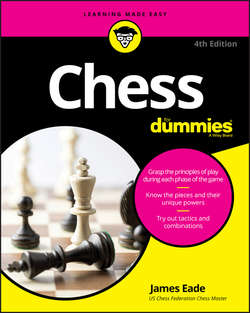Читать книгу Chess For Dummies - Eade James - Страница 7
На сайте Литреса книга снята с продажи.
Part 1
Laying the Groundwork for Champion Chess
Chapter 1
Tackling Chess Basics
Piecemeal: Putting the Pieces on the Board
ОглавлениеTo depict the chessboard in a way that everyone around the world can understand, chess players have developed a set of symbols to represent the chessmen. Each may be represented by a one-letter abbreviation or by an icon. (See Table 1-1 for a list of all the pieces and their symbols.)
TABLE 1-1 Chess Pieces and Their Symbols
I use the piece symbols here to show you how to set up the board, and I use them throughout this book to demonstrate various moves and positions. You may find it helpful to set up your own board piece by piece.
Start with the corners. The rooks go on the corner squares, as shown in Figure 1-6.
© John Wiley & Sons, Inc.
FIGURE 1-6: The rooks take the corner squares.
Next come the knights. Place them next to the rooks (see Figure 1-7).
© John Wiley & Sons, Inc.
FIGURE 1-7: The knights stand by their rooks, along the same rank.
Then put the bishops on the board next to the knights (see Figure 1-8).
© John Wiley & Sons, Inc.
FIGURE 1-8: The bishops stand guard by the knights.
After the bishops come the queens. Your board should now look like the one in Figure 1-9.
© John Wiley & Sons, Inc.
FIGURE 1-9: The queens perch on the squares of their own shade.
The queens always start on a square of the same shade – the white queen starts on a light square, and the black queen starts on a dark square.
Next, place the kings next to the queens, which is only fitting (see Figure 1-10).
© John Wiley & Sons, Inc.
FIGURE 1-10: The kings take their thrones, next to their ladies.
Finally, add the pawns straight across the rank in front of the other pieces, as shown in Figure 1-11.
© John Wiley & Sons, Inc.
FIGURE 1-11: The pawns take their posts on the front line.
If you set up your chessboard by using the preceding directions and it looks like the finished one in Figure 1-11, pat yourself on the back! You’re ready for a game.
A TRIP BACK IN TIME: THE ORIGINS OF CHESS
The true origins of chess are shrouded in the mists of prehistory, which is good because it allows people to say just about anything they want about how the game started without fear of contradiction. From the evidence that does exist, the best guess is that chess, or a game very much like it, originated in Northern India sometime around A.d. 600 and eventually migrated to Europe through China and Persia (modern-day Iran). The ancient Indian game was based on Indian armies and was undoubtedly a pastime for their rulers.
No doubt, this game, called chaturanga, was much like present-day chess. It was played on an 8-x-8-square board and used six different kinds of pieces. The Indian Army was led by the rajah (king) and his chief advisor, the mantri, sometimes referred to as the vizier. The army was represented by foot soldiers, cavalry, chariots, and elephants, and the game had corresponding pieces for all these leaders and warriors.
By the time the game got to Europe, it had changed considerably and continued to change until about the end of the 15th century. The changes basically made the game more familiar to the Europeans who were then playing it. The rajah became the king, the mantri the queen, the foot soldiers the pawns, the cavalry the knights, the chariots the rooks, and the elephants the bishops. Since that time, the game has been essentially stable. Nowadays, chess is played all over the world by the same rules established in Europe in the 15th century, under the control of the Fédération Internationale des Échecs (FIDE), which is French for the International Chess Federation.
